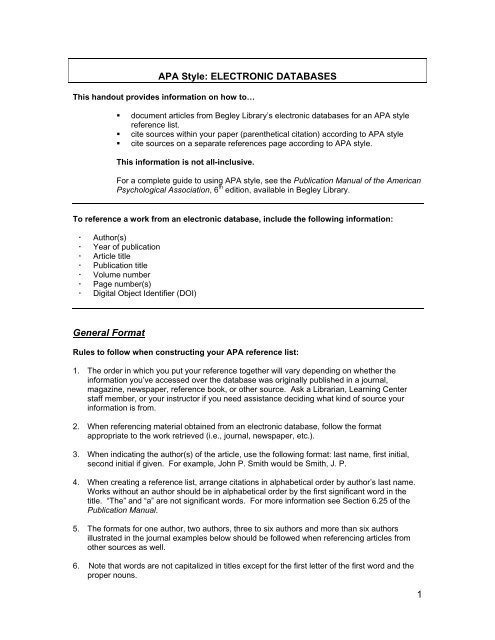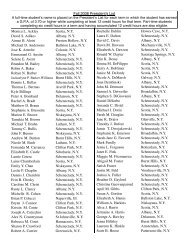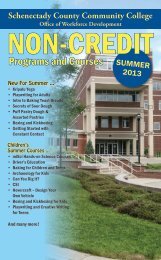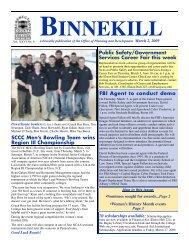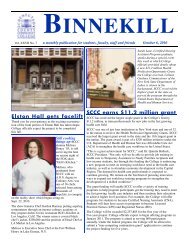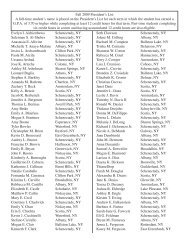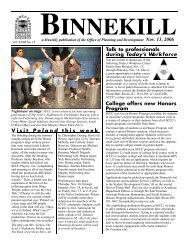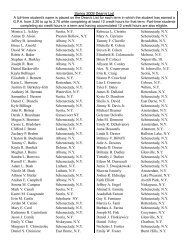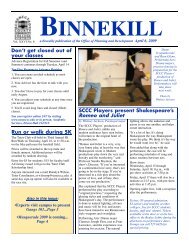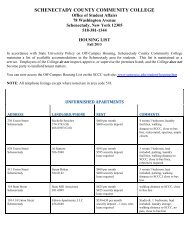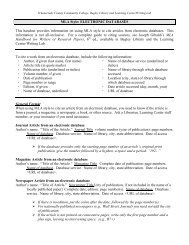1 APA Style: ELECTRONIC DATABASES General Format
1 APA Style: ELECTRONIC DATABASES General Format
1 APA Style: ELECTRONIC DATABASES General Format
You also want an ePaper? Increase the reach of your titles
YUMPU automatically turns print PDFs into web optimized ePapers that Google loves.
<strong>APA</strong> <strong>Style</strong>: <strong>ELECTRONIC</strong> <strong>DATABASES</strong><br />
This handout provides information on how to…<br />
� document articles from Begley Library’s electronic databases for an <strong>APA</strong> style<br />
reference list.<br />
� cite sources within your paper (parenthetical citation) according to <strong>APA</strong> style<br />
� cite sources on a separate references page according to <strong>APA</strong> style.<br />
This information is not all-inclusive.<br />
For a complete guide to using <strong>APA</strong> style, see the Publication Manual of the American<br />
Psychological Association, 6 th edition, available in Begley Library.<br />
To reference a work from an electronic database, include the following information:<br />
� Author(s)<br />
� Year of publication<br />
� Article title<br />
� Publication title<br />
� Volume number<br />
� Page number(s)<br />
� Digital Object Identifier (DOI)<br />
<strong>General</strong> <strong>Format</strong><br />
Rules to follow when constructing your <strong>APA</strong> reference list:<br />
1. The order in which you put your reference together will vary depending on whether the<br />
information you’ve accessed over the database was originally published in a journal,<br />
magazine, newspaper, reference book, or other source. Ask a Librarian, Learning Center<br />
staff member, or your instructor if you need assistance deciding what kind of source your<br />
information is from.<br />
2. When referencing material obtained from an electronic database, follow the format<br />
appropriate to the work retrieved (i.e., journal, newspaper, etc.).<br />
3. When indicating the author(s) of the article, use the following format: last name, first initial,<br />
second initial if given. For example, John P. Smith would be Smith, J. P.<br />
4. When creating a reference list, arrange citations in alphabetical order by author’s last name.<br />
Works without an author should be in alphabetical order by the first significant word in the<br />
title. “The” and “a” are not significant words. For more information see Section 6.25 of the<br />
Publication Manual.<br />
5. The formats for one author, two authors, three to six authors and more than six authors<br />
illustrated in the journal examples below should be followed when referencing articles from<br />
other sources as well.<br />
6. Note that words are not capitalized in titles except for the first letter of the first word and the<br />
proper nouns.<br />
1
7. Include the Digital Object Identifier (DOI) if one was assigned by the publisher. The DOI is<br />
typically added to the first page of the article, near the copyright notice. Add the DOI in this<br />
format: do1:xx.xxxxxxxx.<br />
8. If no DOI was assigned to the article and you retrieved it online, include the home page URL<br />
of the journal, newspaper, or magazine in this format: http://xxx.xxxxxxxx If accessed from a<br />
database, do a quick web search for the periodical’s homepage URL instead of using the<br />
database URL.<br />
Examples:<br />
Journal Article (1 author) with DOI<br />
Author, A. A. (Year). Title of article. Title of Journal, volume, page number-page number. doi:<br />
xx.xxxxxxxx.<br />
Journal Article (1 author) without DOI<br />
Author, A. A. (Year). Title of article. Title of Journal, volume, page number-page number.<br />
Retrieved from http://xxx.xxxxxxxx.<br />
Journal Article (2 authors) with DOI<br />
Author, A. A. & Author, B.B. (Year). Title of article. Title of Journal, volume, page number-page<br />
number. doi: xx.xxxxxxxx.<br />
Journal Article (2 authors) without DOI<br />
Author, A. A. & Author, B.B. (Year). Title of article. Title of Journal, volume, page number-page<br />
Retrieved from http://xxx.xxxxxxxx.<br />
Journal Article (3-6 authors) with DOI<br />
Author, A. A., Author, B. B., Author, C.C, & Author, D. D.(Year). Title of article. Title of Journal,<br />
volume, page number-page number. doi: xx.xxxxxxxx.<br />
Journal Article (3-6 authors) without DOI<br />
Author, A. A., Author, B. B., Author, C.C., & Author, D. D. (Year). Title of article. Title of Journal,<br />
volume, page number-page number. Retrieved from http://xxx.xxxxxxxx.<br />
Journal Article (more than 6 authors) with DOI<br />
Author, A. A., Author, B. B., Author, C.C., Author D. D. Author, E.E., … LastAuthor, Z.Z. (Year).<br />
Title of article. Title of Journal, volume, page number-page number. doi: xx.xxxxxxxx.<br />
Journal Article (more than 6 authors) without DOI<br />
Author, A. A., Author, B. B., Author, C.C., Author D. D. Author, E.E., … LastAuthor, Z.Z, (Year).<br />
Title of article. Title of Journal, volume, page number-page number. Retrieved from<br />
http://xxx.xxxxxxxx.<br />
Magazine Article with DOI<br />
Author, A. A., & Author, B. (Year, Month, day). Title of article. Title of Magazine, Volume, page<br />
number-page number. doi: xx.xxxxxxxx.<br />
Magazine Article without DOI<br />
Author, A. A., & Author, B. (Year, Month, day). Title of article. Title of Magazine, Volume, page<br />
number-page number. Retrieved from http://xxx.xxxxxxxx.<br />
2
Newsletter Article with DOI<br />
Author, A. A. Title of article. Title of Newsletter, volume, page number-page number. doi:<br />
xx.xxxxxxxx.<br />
Newsletter Article without DOI<br />
Author, A. A. Title of article. Title of Newsletter, volume, page number-page number. Retrieved<br />
from http://xxx.xxxxxxxx.<br />
Newspaper Article (no author) with DOI<br />
Title of article. (Year, Month, day). Title of Newspaper, p. number. doi: xx.xxxxxxxx.<br />
Newspaper Article (no author) without DOI<br />
Title of article. (Year, Month, day). Title of Newspaper, p. number. Retrieved from<br />
http://xxx.xxxxxxxx.<br />
Newspaper Article with DOI<br />
Author, A.A. (Year, Month, day). Title of article. Title of Newspaper, p. number. doi:<br />
xx.xxxxxxxx.<br />
Newspaper Article without DOI<br />
Author, A.A. (Year, Month, day). Title of article. Title of Newspaper, p. number. Retrieved from<br />
http://xxx.xxxxxxx<br />
Newspaper Article (discontinuous pages) with DOI<br />
Author, A.A. (Year, Month, day). Title of article. Title of Newspaper, pp. number, number. doi:<br />
xx.xxxxxxxx.<br />
Newspaper Article (discontinuous pages) without DOI<br />
Author, A.A. (Year, Month, day). Title of article. Title of Newspaper, pp. number, number.<br />
Retrieved from http://xxx.xxxxxxxx.<br />
Reference Book Article with DOI<br />
Author, A. (Year). Title of article or chapter. Title of reference book (Vol. #, pp. #-#). doi:<br />
xx.xxxxxxxx.<br />
Reference Book Article without DOI<br />
Author, A. (Year). Title of article or chapter. Title of reference book (Vol. #, pp. #-#). Retrieved<br />
from http://xxx.xxxxxxxx.<br />
Specific Examples<br />
• Journal article with DOI<br />
Powers, M.V. & Workman, P.(2007). Inhibitors of the heat shock response: Biology and<br />
pharmacology. FEBS Letters, 581, 3758–3769. doi:10.1016/j.febslet.2007.05.040<br />
• Magazine without DOI<br />
Quagliata, R. (2010). Hail hits Montalcino. Wine Spectator, 5, 13-13, Retrieved from<br />
http://www.winespectator.com/<br />
• Newspaper article<br />
Ejikeme, A. (2010, June 5). The oil spills we don’t hear about. The International Herald Tribune,<br />
p. 8. http://global.nytimes.com/?iht<br />
3
• RReference<br />
Bo ook Article<br />
Cubissm.<br />
In Encyclo opædia Britannnica<br />
online. Retrieved from<br />
http://www w.britannica.coom/EBcheckeed/topic/1457444/Cubism<br />
Sammple<br />
Parent thetical Cittations<br />
(Ciiting<br />
WITHIIN<br />
your Paaper)<br />
In genneral,<br />
parent thetical citations<br />
are useed<br />
within the text of your paper. The primary<br />
purpoose<br />
for citing g informationn<br />
within the ppaper<br />
is to aallow<br />
the readder<br />
to quicklly<br />
go back too<br />
the reeferences<br />
pa age and find the full citatiion.<br />
The seccond<br />
reason is to be suree<br />
that you arre<br />
citingg<br />
material an nd giving the proper creddit.<br />
The ggeneral<br />
format<br />
for a parenthetical<br />
citaation<br />
is:<br />
For example,<br />
let’s s say the citaation<br />
in yourr<br />
references llooks<br />
like this:<br />
Zepf, B. (2005). Drug D Therapyy<br />
for Patients wwith<br />
Alzheimeer’s<br />
Disease. American Faamily<br />
Physician, 71. Retrieveed<br />
from<br />
http://www w.aafp.org/online/en/home/<br />
/publications/jjournals/afp.hhtml.<br />
Your parenthetica al citation wiithin<br />
the textt<br />
of your paper<br />
would loook<br />
like this:<br />
As yoou<br />
can see, if f someone iss<br />
reading your<br />
paper, theey<br />
will easilyy<br />
see the (Zeppf,<br />
2005)<br />
citatioon,<br />
and can easily find itt<br />
in the refereences<br />
page……Author<br />
andd<br />
Date.<br />
Otherr<br />
<strong>Format</strong>s:<br />
The aabove<br />
examp ple was for citing<br />
a journal<br />
article thaat<br />
has an authhor<br />
and publication<br />
datee.<br />
This fformat<br />
is fine e if you indeed<br />
have thosse<br />
parts. Buut<br />
what if it’s a website, oor<br />
somethingg<br />
with nno<br />
author?<br />
A commmon<br />
situation<br />
is an enccyclopedia<br />
article<br />
with noo<br />
author or AANY<br />
article wwith<br />
no<br />
authoor.<br />
The ppresent<br />
peril. (1865, June 24). Harper’ss<br />
Weekly,9, 3386.<br />
Retrieveed<br />
from<br />
http://www w.harpers.org/ /subjects/WeeeklyReview<br />
If there<br />
is no auth hor, but theree<br />
is a title, usse<br />
the title inn<br />
the parenthhetical<br />
citatioon<br />
along withh<br />
the yeear<br />
it was pu ublished:<br />
•<br />
(Last name e of author(s) ), date of publlication)<br />
Families<br />
dealing withh<br />
Alzheimers disease encoounter<br />
difficulty<br />
accessing social<br />
services fo or which they are qualified (Zepf, 2005). .<br />
The Civil War<br />
was fought, with both siddes<br />
believing that God wass<br />
on their sidee<br />
(“The<br />
Present Peril l”, 1865).<br />
To sitte<br />
a specific PART of a ssource,<br />
a bit more informmation<br />
is requuired.<br />
You mmust<br />
indicatee<br />
the paage,<br />
chapter r, figure, tablle,<br />
or equatioon<br />
at the apppropriate<br />
point<br />
within thee<br />
text. See<br />
exammples<br />
below:<br />
4
Assuming g the citationns<br />
in the refeerences<br />
pagee<br />
look like this:<br />
Costaa<br />
Rica (2006) . The World AAlmanac<br />
andd<br />
Book of Factts.<br />
Retrievedd<br />
from<br />
http://www w.oclc.org/suppport/documenntation/firstseearch/databasses/dbdetails/<br />
/details/Worldd<br />
Almanac.h htm<br />
NOTEE:<br />
Please not te that there iis<br />
no author foor<br />
this referennces<br />
citation. This situatioon<br />
is frequentlly<br />
encountere ed for encycloopedias<br />
and wwebsites.<br />
The<br />
title takes thhe<br />
place of thhe<br />
author<br />
when listin ng the citationn<br />
in the references<br />
page ass<br />
well as whenn<br />
cited within the text of the<br />
paper.<br />
The Paren nthetical Citaation<br />
could loook<br />
like this:<br />
The ccountry<br />
of Cos sta Rica, wheen<br />
translated iinto<br />
English, lliterally<br />
means<br />
rich coast ( “Costa Rica”, ,<br />
par. 33,<br />
2006).<br />
To the<br />
reader, this s would indicate<br />
that thee<br />
particular iddea<br />
or quotee<br />
was found iin<br />
the third<br />
paraggraph<br />
of the encyclopediia<br />
article found<br />
online.<br />
Also note that the ere was NO aauthor<br />
for this<br />
article. If you cannot ffind<br />
an authoor<br />
for the<br />
articlee<br />
and/or web bsite, use thee<br />
title, then tthe<br />
page/paraagraph<br />
numbber,<br />
then thee<br />
year if<br />
availaable.<br />
NOTEE:<br />
On interne et sites, including<br />
electroonic<br />
encycloopedias,<br />
webb<br />
pages, and,<br />
at times,<br />
databbases,<br />
the pa age numberss<br />
as they apppear<br />
in the PRINTED<br />
verssion<br />
are not ggiven.<br />
Thereefore,<br />
the paragraphs<br />
need<br />
to be inclluded<br />
as partt<br />
of the citation<br />
information.<br />
You ccan<br />
get inven ntive with hoow<br />
you cite ssources<br />
by inncluding<br />
the author as paart<br />
of your<br />
text aand<br />
citing the e year in parrenthesis<br />
as described beelow:<br />
Sourcce-reflective<br />
statements give you an opportunity to assert yoour<br />
authorial voice.<br />
Writerrs<br />
use source e-reflective staatements<br />
to pprovide<br />
editorial<br />
comment, clarification, qualification,<br />
ampliffication,<br />
disse ent, agreemennt,<br />
and so on.<br />
In the followwing<br />
example, , the absencee<br />
of a source-<br />
reflecctive<br />
statemen nt creates unccertainty<br />
as too<br />
whether the writer has finnished<br />
citing aan<br />
Internet<br />
sourcce<br />
or has mere ely moved froom<br />
quoting dirrectly<br />
to paraphrasing.<br />
Sosteric c (1996, Introoduction)<br />
has noted that "exponential<br />
grrowth<br />
of the primary<br />
literature coupled c with aan<br />
explosive ggrowth<br />
in the cost of distribbuting<br />
scholarrly<br />
informationn<br />
has put se erious strain oon<br />
the financiaal<br />
resources oof<br />
libraries and<br />
universitiess."<br />
This<br />
demand fo or and cost of distributing pprimary<br />
literature<br />
suggests that we can eexpect<br />
more<br />
electronic journals j to apppear<br />
online in<br />
the next feww<br />
years—sureely<br />
a benefit tto<br />
scholarly<br />
communication.<br />
The above e samples arre<br />
provided a<br />
concerned d. The mostt<br />
common sit<br />
not repres sented here, please the P<br />
Psycholog gical Associiation;<br />
6 th as accurate eexamples<br />
ass<br />
far as formaat<br />
is<br />
tuations are presented aabove.<br />
If youur<br />
situation iss<br />
Publication MManual<br />
of thee<br />
American<br />
ediition<br />
(Ready Reference SShelf).<br />
5
Sample References Page<br />
Here is a sample of how your page should be set-up.<br />
6
This guide is based on the publication Manual of the American Psychological Association, 6 th edition.<br />
The 5 th edition version was created by Carrie Laier, January 2006 and revised by Mark Lasek, July 2006.<br />
Updated for the 6 th edition by Tom Mangano and Sarah Russo, September 2010.<br />
7


